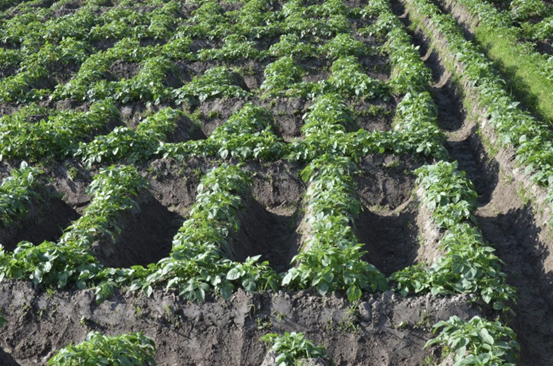2. Potato cultivation in Sankhu
Figure 1 shows the agricultural land classification of approximately 250 ha in Sankhu. This area is dominated by subsistence rice farmers with a management area of 10 to 20 ares, and potato is an important cash crop after the paddy rice harvest. The division of agricultural land mainly reflects differences in water use conditions, such as canals that take water from weirs on the Sali Nadi River and small channels that flow from the hillsides.
Figure 2 shows the cropping rotation in Sankhu: since the 1990s, the demand for vegetables has increased due to the rapid population growth in Kathmandu, and in Upstream I, where water availability is good, seed potatoes are planted immediately after the rice harvest and twice for potato. In other words, summer potato is planted in September and harvested from November to December. Winter potato is planted in January and harvested in April. In recent years, rain-fed tomatoes have become increasingly popular.
In the 1990s, the downstream areas III and IV lacked irrigation water and rice planting was delayed by about one month compared to the upstream areas, and wheat was planted as a post-crop. Since more than a decade ago, farmers began to use small pumping pumps to irrigate their fields along the Sali Nadi River, and potatoes and tomatoes were also produced in the downstream area, resulting in a significant decrease in the area under cultivation for wheat.
The main potato variety is Janakdev, and seed potatoes are home-grown potato, weighing 30-40 g for summer potato and 80-120 g for winter potato. Virus-free seed potatoes continue to be difficult to obtain, making seed potato renewal a challenge. Currently, home-produced summer potatoes are used as seeds for winter potatoes, so careful selection of seed potatoes is necessary.
Potato cultivation is irrigated with high ridges arranged in a comb shape. All ridging is done by labor, with 70 cm wide rows at planting, 8-12 cm between plants, and small seed potato size and dense planting. The airy, undrained field space in the community requires attention to spread in the event of an epidemic outbreak.
The farming is labor intensive. Seasonal labor is employed during planting, harvesting. They use small farming tools such as hand hoes (kodari), hand plows (koto), and sickles. Foot-pedal threshing machine is used at the time of rice harvesting and in winter potato season, a taylor-type cultivator is used for plowing.

Fig.1. Agricultural zones in Sankhu village

Fig. 2. Cropping calendar of major crops in Sankhu
Photo.1. All high ridges are made by hand and filled with irrigation water
